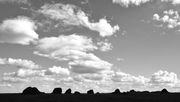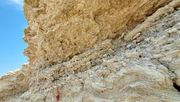Sapele Countertops
The price of granite for our kitchen countertops was going to be north of $3000 for the stone, the cutting, and installation (~85 square feet), so we started looking at wood alternatives almost immediately. There are several pre-made butcherblock makers out there, but the look wasn't right for our 114-year old home.
What about shop-made slab countertops? I made a list of hardwood alternatives: cherry, walnut, maple, and true mahogany. Cherry would look great, but be too soft. Walnut is inexpensive from my local sawyer, but too dark. Maple was plenty hard, but too boring. Mahogany was a little more expensive, but maybe too soft. I determined 6/4 stock would work fine, but could not decide on a species.
Then I noticed the stack of quartersawn ribbon-stripe sapele. The African hardwood (suh-PEE-lee, Entandrophragma cylindricum) is stable and beautiful. Its got just the right blend between red and brown. Guitar makers use it.
I bought the lot, some $900 worth. The planks were long, 5" to 9" wide, and clear. Most boards had grain patterns with gentle curves.
In the shop I broke down the planks to 4" wide boards and cut for rough length. I carefully matched the grain across the joints and cut slots for #10 biscuits spaced every 8" in tandem. I hand planed each joint to insure perfect glue-ups. I clamped up the slabs and set aside to dry.
A local cabinet shop thicknessed and wide belt sanded them flat. The parts finished out at 1-1/8" thick with 220 grit ($175). I trimmed them to size on the table saw and added a 1/8" chamfer to the front edges. All tops installed at 26-1/2" wide (counter depth).
I hand sanded to 320, removed the dust with thinner, and finished them with 7 coats of Waterlox Original medium sheen (used one gallon, $75), using a cotton pad or hospital gauze. A respirator and gloves are crucial (3M 7000 Series half mask respirator, 6001 VOC cartridges, nitrile gloves). Each coat cured for a full 24 hours before a wipe down with thinner and a light wet sanding (water) with wet/dry 320. After the first 2 coats, there is a noticeable reduction in the amount of Waterlox needed. I did all the finishing in my workshop. Sapele takes Waterlox beautifully; no blotching. The ribbon stripe shimmers. I used boiled linseed oil to finish the bottoms.
I leveled the counters, applied a thick bead of high quality silicone caulk/sealant ($8/tube), and screwed to the countertops through the top braces via oversized holes. The cabinets are white (Benjamin Moore Advance, no tint). I used cup-type countertop bolts to join the parts where they came together at 90-degree and 45-degree angles. These bolts fit into shallow pockets drilled in the underside with a forstner bit and hand tightened with a wrench.
All told, we paid about $1500 for the wood, finish, fasteners, sandpaper, and various other consumables.























